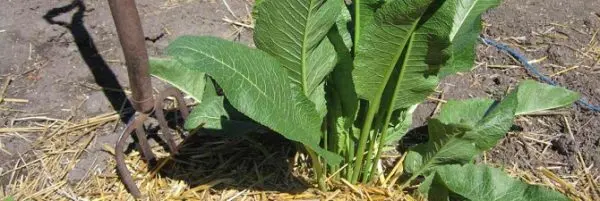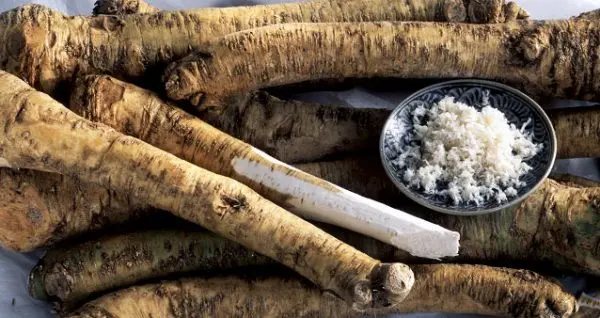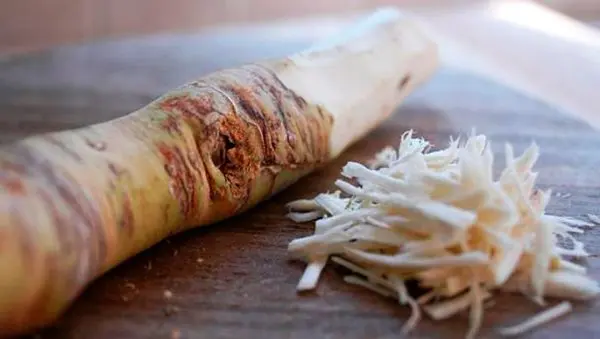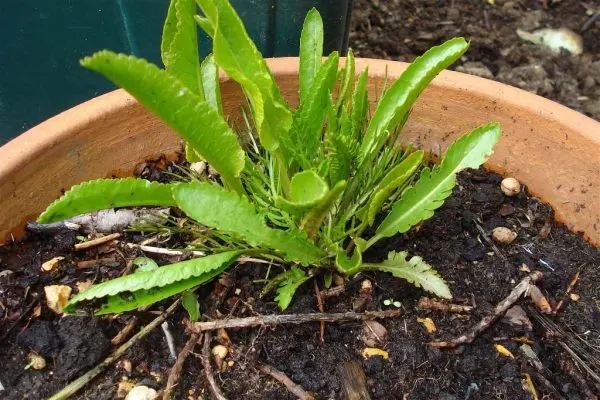Contents
A perennial horseradish plant is a permanent resident in garden plots. Growing horseradish in the country and caring for it is a simple process. A plant without measure is independent in distribution. An ornament to any dish or pickle, horseradish is full of vitamin C, calcium salts, sodium, and also contains mustard and allyl oil. With proper care, the plant will delight with beautiful leaves, as well as a fleshy root. Being cold-resistant, seedlings are ready for planting both in early spring and late autumn.
Where is the best place to plant?
Planting horseradish does not require any special preparations, at least not more than any other plant. Try to choose a place where nothing has grown before or early-ripening crops have grown. Suitable beds from under potatoes, beets, tomatoes, cucumbers.

The culture is unpretentious to the soil, but it is worth choosing a place on a site with loamy soil or drained peat bogs. Before planting, you need to properly prepare the soil. There are different methods of preparing the soil for a future horseradish plantation. In one of them, you will need 6-8 kg of humus, 2 tbsp. spoons of nitrophoska, 3 tbsp. spoons of wood ash. All this needs to be mixed, dug up, diluted with water, and then prepare the roots for planting.
Another “recipe” is applied in the fall. 5-10 kg of manure, 70-100 g of superphosphate, 50 g of potassium chloride are imported to the selected site. Remember: the thicker the layer of prepared earth, the better horseradish will grow.
Video “On the method of growing horseradish in a barrel”
An informative video with an interesting suggestion for planting and growing a plant in a barrel.
Planting in the garden
Growing this crop requires preliminary seed preparation. Before planting the seedlings, you need to take them out into the light for 35-40 days to awaken the buds. Cover the middle of the roots with foil and place in a warm place. Thus, many lateral roots are not formed and the plant will grow strong and powerful.
The roots sprouted from the seeds should be sorted out – it is better to put the small roots into cooking, and cut the large ones, 15-20 cm long. An incision is made from above – cutting off the top to make a ring, and from below – obliquely. So it will be more convenient to disassemble where the top is, and where the hell is the bottom. Next, the selected roots are wiped with a hard cloth or glove to remove small shoots, thereby controlling the propagation of the culture.

In the spring, approximately in the second half of April, the cuttings are placed in the ground at an inclination of 30-40 °. Make sure that the distance between the roots is 20-30 cm, and between the beds – about 60 cm. Sprinkle the upper end of the cutting with earth and trample it with your foot, creating tight contact with the ground. Remember that this culture does not like shading, so do not allow it to be adjacent to densely growing fruit or berry plants. It is best to plant in an open area. Having correctly planted seedlings on the site, you will receive a first-class product at home. In addition, transplanting this plant is a chore.
Cultivation and care
Caring for a plant is a simple matter – it is extremely unpretentious. Water the plants regularly, weed thoroughly, loosen the soil between the beds. In spring and summer, feed the plants with a mixture of fertilizers of urea, superphosphate, potassium chloride – this will help to propagate large, fleshy roots.

Another way to get thick roots is to clean them from the roots, cutting off the leaves. The ideal month is July, when the leafy part grows to 18-20 cm. Carefully expose the top of the root, cut off all the shoots, and then carefully return the earth back and water the beds well.
Incorporate pest control into plantation care. Babanukha willingly breeds in the garden next to horseradish to huge populations. Insects eat the leaves and rhizome of the plant. Destroying them is easy, but you will have to do rescue procedures several times per season. Prepare a warm mustard-pepper solution, in a ratio of 100 g of hot spices to 1 bucket of water.
Spray generously on the leaves in the beds until you are completely rid of the insects. This will help you grow a good crop. When can you dig horseradish? At the end of October, the rhizomes are already formed enough to send them to cooking.

How to limit the fuck
Care of the beds should begin long before planting the roots. The entire preparatory process takes place at home, without requiring special skills. There are several ways to fence off the horseradish growth zone from the rest of the vegetation:
- old slate is suitable, which is cut into narrow strips, and then dug into the ground;
- before preparing the land, the pit is lined with roofing felt or linoleum;
- the least expensive option is plastic bottles, which are instilled with their neck down 20-30 cm, tamp them well, sprinkle them with earth on top to make a neat fence;
- an elegant way is to plant horseradish in a barrel, small buckets or boils are suitable, where cuttings are planted, this method will greatly facilitate the care of plants and prevent them from growing into neighboring beds.
Planted and carefully grown horseradish will thank you for your care and work with a rich harvest.
Video “Useful information about horseradish for gardeners”
In this video, an expert shares knowledge about this wonderful root vegetable.









